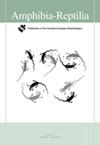巴西古猿palpebrosus(居维叶,1807)矮凯门鳄的颜色和斑纹的地理变异
IF 1.3
4区 生物学
Q3 ZOOLOGY
引用次数: 0
摘要
鳄鱼的颜色变化与体型、环境和遗传结构有关,但对古鳄属(鳄鱼科)的颜色变化知之甚少。Paleosuchus palpebrosus(矮凯门鳄)的不同遗传谱系在整个物种的广泛分布中占据了不同的环境,并且都是神秘的颜色。在2008年至2019年间,我们从四个基因不同的地理分支中捕获了187只P.palpebrosus,并记录了它们的头部颜色。此外,我们还确定了95个个体(鼻喷口长度22-109厘米)的亚样本的下颌和腹部斑点模式。PERMANCOVA被用来研究头部颜色和斑点图案、凯门鳄的体型、性别、地理谱系以及环境温度之间的关系。头部颜色、下巴和腹部斑点模式的变化与遗传谱系、鼻喷口长度和温度有关,但该模型仅解释了数据中约45.4%的变化。性别与头部颜色、下巴和腹部斑点模式没有显著关系。居住在较冷气候中的矮凯门鳄往往比来自温暖地区的个体更黑,而来自“塞拉多·潘塔纳尔”和“玻利维亚”谱系的个体通常比“亚马逊”和“马德拉”谱系的颜色更黑。然而,不同谱系中给定大小的个体在颜色模式上有很大的重叠,单独的颜色不能用来区分谱系。根据我们的定量分析,Natterer关于“Cerrado-Pantanal”谱系诊断出的头部颜色的假设不能完全被接受,尽管这些表型特征的地理分布存在差异,并且“Cerrado Pantanal)谱系在谱系中是最明显的。本文章由计算机程序翻译,如有差异,请以英文原文为准。
Geographic variation in colour and spot patterns in Dwarf Caiman, Paleosuchus palpebrosus (Cuvier, 1807) in Brazil
Colour variation in crocodilians is associated with size, environment and genetic structure, but little is known about colour variation in the genus Paleosuchus (Alligatoridae). Different genetic lineages of Paleosuchus palpebrosus (Dwarf caiman) occupy different environments throughout the species extensive distribution, and all are cryptically coloured. We captured 187 P. palpebrosus and recorded their head colour from four genetically distinct geographic clades between 2008 and 2019. Additionally, we determined the jaw and belly spot pattern of a subsample of 95 individuals (22–109 cm snout-vent length). PERMANCOVA was used to investigate the relationships between head colour and spot patterns, to the caiman size, sex, and geographic lineage, as well as ambient temperature. Variation in head colour, and jaw and belly spot patterns, were related to genetic lineage, snout-vent length and temperature, but the model explained only ∼45.4% of the variance in the data. Sex was not significantly related to the head colour, or jaw and belly spot patterns. Dwarf caimans inhabiting cooler climates tend to be darker than individuals from warmer areas, and individuals from the “Cerrado-Pantanal” and “Bolivia” lineages generally darker than the “Amazon” and “Madeira” lineages. However, individuals of a given size in different lineages overlap greatly in colour patterns and colour alone could not be used to distinguish lineages. The Natterer’s hypothesis of head-colour as diagnose from “Cerrado-Pantanal” lineage, cannot be completely accepted according our quantitative analysis, although there are a variation in the geographic distribution of these phenotypic traits, and the “Cerrado-Pantanal” lineage had been the most distinct among the lineages.
求助全文
通过发布文献求助,成功后即可免费获取论文全文。
去求助
来源期刊

Amphibia-Reptilia
生物-动物学
CiteScore
3.10
自引率
6.20%
发文量
39
审稿时长
6-12 weeks
期刊介绍:
Amphibia-Reptilia is a leading European multi-disciplinary journal devoted to most of the aspects of herpetology: ecology, behaviour, evolution, conservation, physiology, morphology, paleontology, genetics, and systematics.
Amphibia-Reptilia publishes high quality original papers, short-notes, reviews, book reviews and news of the Societas Europaea Herpetologica (SEH). The Societas Europaea Herpteologica (SEH) website is located at: www.seh-herpetology.org.
 求助内容:
求助内容: 应助结果提醒方式:
应助结果提醒方式:


